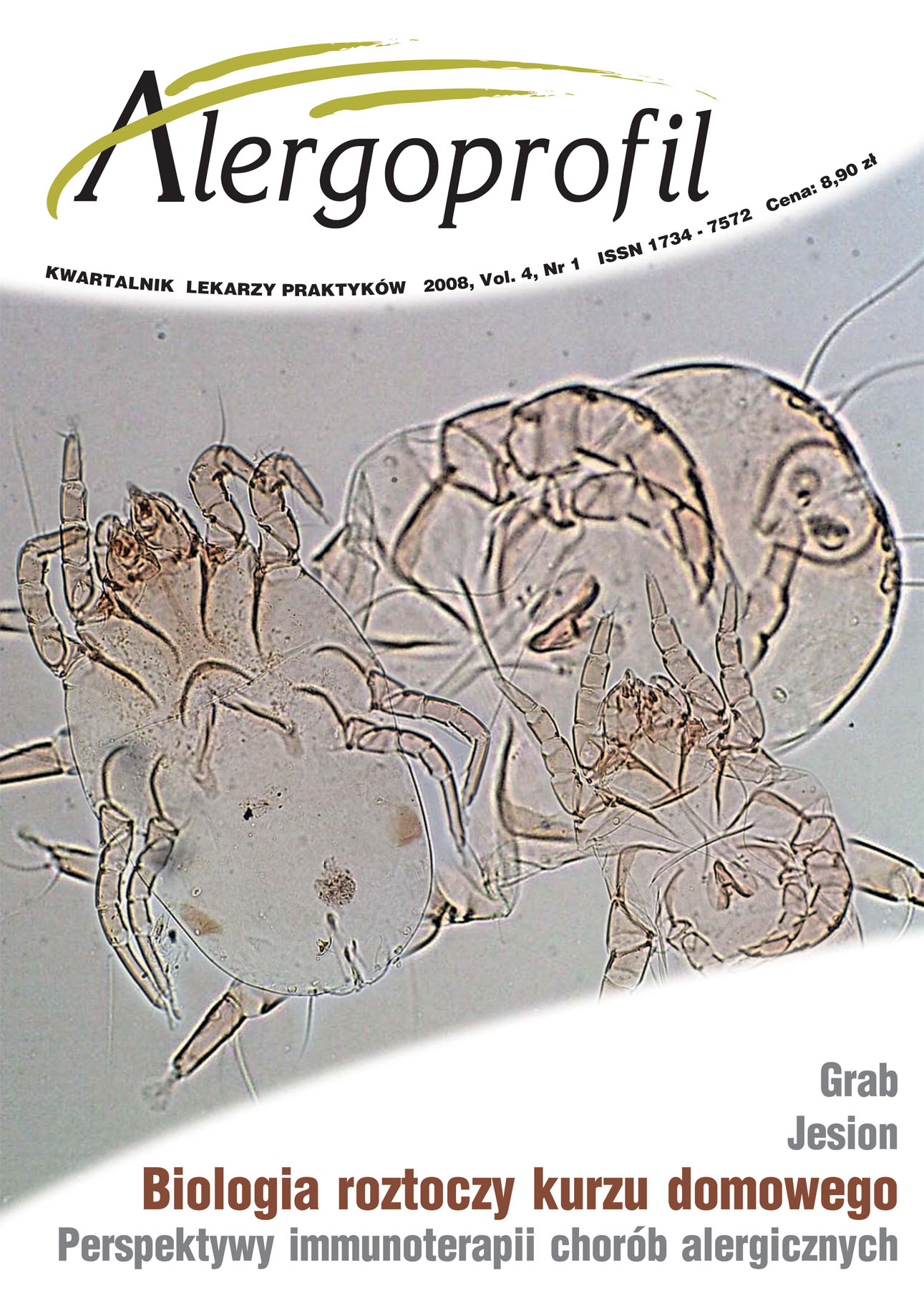The role of eosinophil in chronic autoimmunologic urticaria
Main Article Content
Abstract
This study describes the role of eosinophil in pathogenesis of chronic autoimmunologic urticaria. We present the actual data about migration of this cell into the inflammatory sites in response to the different chemotactic stimuli as well as secretion of wide range of proinflammatory mediators. This study also describes a newly discovered possibility of immediate activation of this cell by anti-FcεRII autoantibodies as well as actual and forthcoming therapeutic possibilities in the treatment of autoimmune urticaria.
Downloads
Article Details
Copyright: © Medical Education sp. z o.o. This is an Open Access article distributed under the terms of the Attribution-NonCommercial 4.0 International (CC BY-NC 4.0). License (https://creativecommons.org/licenses/by-nc/4.0/), allowing third parties to copy and redistribute the material in any medium or format and to remix, transform, and build upon the material, provided the original work is properly cited and states its license.
Address reprint requests to: Medical Education, Marcin Kuźma (marcin.kuzma@mededu.pl)
References
2. Bernstein J.A.: Chronic urticaria: an evolving story. Isr. Med. Assoc. J. 2005, 7: 774-777.
3. Grattan C.E., Wallington T.B., Warin R.P. et al: A serological mediator in chronic idiopathic urticaria - a clinical, immunological and histological evaluation. Br. J. Dermatol. 1986, 114: 583-590.
4. Caproni M., Volpi W., Macchia D. et al.: Infiltrating cells and related cytokines in lesional skin of patients with chronic idiopathic urticaria and positive autologous serum skin test. Exp. Dermatol. 2003, 12: 621-628.
5. Hide M., Francis D.M., Grattan C.E.H. et al.: Autoantibodies against the high-affinity IgE receptor as a cause of histamine release in chronic urticaria. N. Engl. J. Med. 1993, 328: 1599-1604.
6. Brunetti L., Francavilla R., Miniello V.L. et al.: High prevalence of autoimmune urticaria in children with chronic urticaria. J. Allergy Clin. Immunol. 2004, 114: 922-927.
7. Fusari A., Colangelo C., Bonifazi F. et al.: The autologous serum skin test in the follow-up of patients with chronic urticaria. Allergy 2005, 60: 256-258.
8. Erbagci Z.: Multiple NSAID intolerance in chronic idiopathic urticaria is correlated with delayed, pronounced and prolonged autoreactivity. J. Dermatol. 2004, 31: 376-382.
9. Kaplan A.P., Joseph K., Shibayama Y. et al.: Bradykinin formation: plasma and tissue pathways and cellular interactions. W: Inflammation: basic principles and clinical correlates. Gallin J., Snyderman R. (red.). Wyd. 3, Lippincott, Williams and Wilkins, Philadelphia 1999: 331-347.
10. Ward P.A., Hill J.H.: C5 chemotactic fragments produced by an enzyme in lysosomal granules of neutrophils. J. Immunol. 1970, 104: 535-543.
11. Fiebiger E., Hammerschmid F., Stingl G. et al.: Anti-FceRIα autoantibodies in autoimmune-mediated disorders. Identification of a structure–function relationship. J. Clin. Invest. 1998, 101: 243-251.
12. Tam S.W., Demissie S., Thomas D. et al.: A bispecific antibody against human IgE and human FcgammaRII that inhibits antigen-induced histamine release by human mast cells and basophils. Allergy 2004, 59: 772-780.
13. Horn M.P., Pachlopnik J.M., Vogel M. et al.: Conditional autoimmunity mediated by human natural anti-Fc(epsilon)RIalpha autoantibodies? FASEB J. 2001, 15: 2268-2274.
14. Asero R., Lorini M., Chong S.U. et al.: Assessment of histamine-releasing activity of sera from patients with chronic urticaria showing positive autologous skin test on human basophils and mast cells. Clin. Exp. Allergy 2004, 34: 1111-1114.
15. Giembycz M.A., Lindsay M.A.: Pharmacology of the eosinophil. Pharm. Rev. 1999, 51: 213-340.
16. Tavernier J. H., Plaetinck G., Guisez Y. et al.: The role of interleukin-5 in the production and function of eosinophils. W: Hematopoietic Cell Growth Factors and Their Receptors. Whetton and Gordon (red.). Plenum Press, New York 1996: 321-361.
17. Sur S., Lam J., Bouchard P.: Immunomodulatory effects of IL12 on allergic lung inflammation depend on timing of doses. J. Immunol. 1996, 157: 4173-4180.
18. Forssmann U., Uguccioni M., Loetscher P. et al: Eotaxin-2, a novel CC chemokine that is selective for the chemokine receptor CCR3 and acts like eotaxin on human eosinophil and basophil leukocytes. J. Exp. Med.1997, 185: 2171-2176.
19. Ying S., Robinson D.S., Meng Q. et al.: C-C chemokines in allergen-induced late-phase cutaneous responses in atopic subjects: association of eotaxin with early 6-hour eosinophils, and eotaxin-2 and monocyte chemoattractant protein-4 with the later 24-hour tissue eosinophilia, and relationship to basophils and other C-C chemes (monocyte chemoattractant protein-3 and RANTES). J. Immunol.1999, 163: 3976-3984.
20. Keane-Myers A., Wysocka M., Trinchieri G. et al.: Resistance to antigen-induced airway hyperresponsiveness requires endogenous production of IL-12. J. Immunol. 1998, 161: 919-926.
21. Trinchieri G.: Interleukin-12: a proinflammatory cytokine with immunoregulatory functions that bridge innate resistance and antigen-specific adaptive immunity. Ann. Rev. Immunol. 1995, 13: 251-276.
22. Jonkers R.E., van der Zee J.S.: Anti-IgE and other new immunomodulation-based therapies for allergic asthma. Neth. J. Med. 2005, 63: 121-128.
23. Caproni M., Volpi W., Macchia D. et al.: Infiltrating cells and related cytokines in lesional skin of patients with chronic idiopathic urticaria and positive autologous serum skin test. Exp. Dermatol. 2003, 12, 621-628.
24. Sabroe R.A., Poon E., Orchard G.E. et al.: Cutaneous inflammatory cell infiltrate in chronic idiopathic urticaria: comparison of patients with and without anti-FcepsilonRI or anti-IgE autoantibodies. J. Allergy Clin. Immunol. 1999, 103: 484-493.
25. O’Donnel B.F., Barr R.M., Black A.K. et al.: Intravenous immunoglobulin in autoimmune chronic urticaria. Br. J. Dermatol. 1998, 138: 101-106.
26. Grattan C.E., Francis D.M., Slater N.G.: Plasmapheresis for severe, unremitting, chronic urticaria. Lancet 1992, 2(8801): 1078-1080.
27. Grattan C.E., O’Donnell B.F., Francis D.M. et al.: Randomized double-blind study of cyclosporin in chronic ’idiopathic’ urticaria. Br. J. Dermatol. 2000, 143: 365-372.
28. Płusa T.: Strategia leczenia chorób alergicznych. PDiA 2003, 20: 66-72.
29. Leckie M.J., Ten Brinke A., Khan J. et al.: Effects of an interleukin-5 blocking monoclonal antibody on eosinophils, airway hyper-responsiveness, and the late asthmatic response. Lancet 2000, 356(9248): 2144-2148.
30. Dent G., Hadjicharalambous C., Yoshikawa T. et al.: Contribution of eotaxin-1 to eosinophil chemotactic activity of moderate and severe asthmatic sputum. Am. J. Respir. Crit. Care Med. 2004, 169: 1110-1117.

